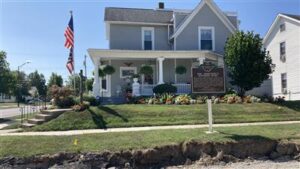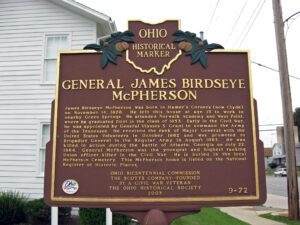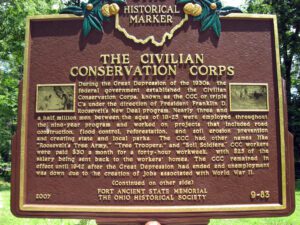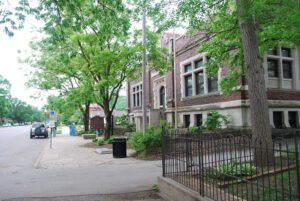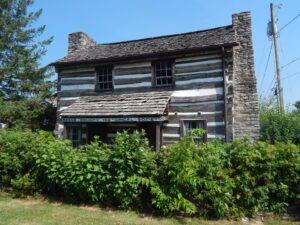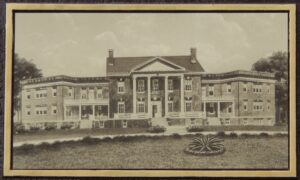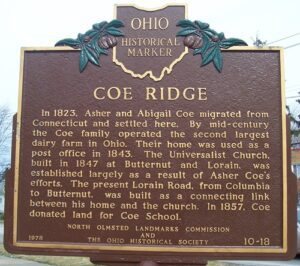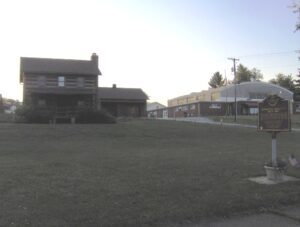, OH
Stephen and Viola Armstrong moved their family, including 13-year-old Neil and his younger siblings, June and Dean, to the house at 601 West Benton Street in 1944. Here, Neil explored his fascination with flying by reading aviation magazines and building model airplanes. Neil completed flying lessons at nearby Port Koneta airport and earned his pilot’s license on his sixteenth birthday, even before receiving a driver’s license. Neil graduated from Blume High School in 1947 and studied aeronautical engineering at Purdue University on a Navy scholarship. The Korean conflict interrupted his studies, but he left the Navy as a decorated combat pilot, flying 78 missions. After graduating from Purdue in 1955, Neil worked at what would become the NASA Glenn Research Center in Cleveland. Soon after he became a test pilot at Edwards Air Force Base in California. (Continued on other side)
, OH
James Birdseye McPherson was born in Hamer’s Corners (now Clyde) on November 14, 1828. He left this house at age 13 to work in nearby Green Springs. He attended Norwalk Academy and West Point, where he graduated first in the class of 1853. Early in the Civil War, he was appointed by General Ulysses S. Grant to command the Army of the Tennessee. He received the rank of Major General with the United States Volunteers in October 1862 and was promoted to Brigadier General in the Regular Army in August 1863. He was killed in action during the battle of Atlanta, Georgia on July 22, 1864. General McPherson was the youngest and highest ranking Union officer killed in the Civil War. He is buried in the local McPherson Cemetery. This McPherson home is listed on the National Register of Historic Places.
, OH
During the Great Depression of the 1930s, the federal government established the Civilian Conservation Corps, known as the CCC or triple C’s under the direction of President Franklin D. Roosevelt’s New Deal program. Nearly three and a half million men between the ages of 18-25 were employed throughout the nine-year program and worked on projects that included road construction, flood control, reforestation, and soil erosion prevention and creating state and local parks. The CCC had other names like “Roosevelt’s Tree Army,” “Tree Troopers,” and “Soil Soldiers.” CCC workers were paid $30 a month for a forty-hour workweek, with $25 of the salary being sent back to the workers’ homes. The CCC remained in effect until 1942 after the Great Depression had ended and unemployment was down due to the creation of jobs associated with World War II.
, OH
Born in Chillicothe in 1872, Burton Stevenson’s life was devoted to the written word as a prolific author and anthologist, and as a librarian. Following stints as a journalist while a student at Princeton University and then at newspapers in Chillicothe, Stevenson became the librarian of the city’s public library in 1899. He held the post for 58 years. Stevenson helped secure a Carnegie Library for Chillicothe, completed in 1906, and became prominent for his service during World War I. He founded a library at Camp Sherman (an army training camp north of the city), which became a model for others nationally.
, OH
James Sr. and Rebecca (Junkin) Galloway moved with their family to Greene County from Kentucky in 1798, constructing their first home, a small log cabin. Galloway built the present structure around 1799 near the bend in the Little Miami River near what is now Goes Station on U.S. 68. In 1936, the Greene County Historical Society moved the home to the corner of Second and Monroe streets and then to the present site in 1965. The 1974 Xenia Tornado caused serious damage to the building, which has been restored and maintained by the historical society. James Sr. served as a hunter during the American Revolution, procuring game for the army, and while in Ohio, was the first treasurer of Greene County. His son James Jr. served as the first County Surveyor.
, OH
The Hillcrest Children’s Home stood near this site in Wheelersburg and opened in 1921 to the first 57 of many children who would come to live there. A 50-room building intended for 100 children, Hillcrest often housed double to triple that number. The extended community supported Hillcrest, providing entertainment, sponsoring activities, and donating presents for the children whose times there left indelible memories. The home closed in 1970 and was razed the following year.
, OH
In 1823, Asher and Abigail Coe migrated from Connecticut and settled here. By mid-century the Coe family operated the second largest dairy farm in Ohio. Their home was used as a post office in 1843. The Universalist Church, built in 1847 at Butternut and Lorain, was established largely as a result of Asher Coe’s efforts. The present Lorain Road, from Columbia to Butternut, was built as a connecting link between his home and the church. In 1857, Coe donated land for Coe School.
, OH
Surgeon and songwriter Brewster Higley VI was born in Rutland in 1823, the grandson of Brewster Higley IV, a veteran of the American Revolution and founder of Rutland. Higley began studying medicine at age 18 and opened his first practice in Pomeroy, moving to Indiana and then to Kansas in 1871. The following year he penned the words to the famous Western song, “Home on the Range.” This perennial favorite became the state song of Kansas in 1947. Oh, give me a home where the buffalo roam, And the deer and the antelope play, Where seldom is heard a discouraging word, And the skies are not cloudy all day.


